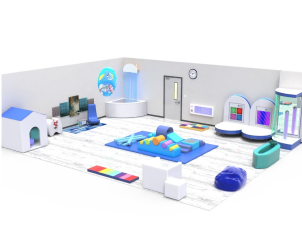Sensory kits are not just for home or school! Libraries, museums and airports are responding to special needs with sensory tools in a kit or sensory room. Sometimes an accommodation intended for one audience works for others too, observes Kate Carter, Youth Services Project Librarian at Multnomah County Library in Portland, Oregon. Read our interview with Kate about her community’s take on what sensory solutions worked best for them.
What's the story behind the sensory accommodation kits in your 19 branch libraries?
We noticed some kids were struggling. Our goal is to make the library a more welcoming place. For example, our preschool sensory story time is designed for kids on the spectrum. We provide a large visual schedule with a set routine, dim the lights and keep the group small. Yet there was an opportunity to do even more, according to the families as well as staff members with children on the spectrum.
About 18 months ago, we introduced sensory kits in the three libraries that host sensory storytime. Then we fine-tuned the sensory kit based on input from the community, a professional aid, and the autism society director in Portland. Now all of our 19 branches will have these sensory kits.
Where can you find the sensory kits in the libraries, and what's inside?
We place the sensory kits in the children's area so it's accessible without needing to ask for it. Each kit has a transformer sensory sack, weighted lap pad, fidgets, a wiggle cushion, howdahug seats, noise cancelling headphones, and a visual schedule. Initially we had a play tunnel but parents and caregivers found it hard to fold quickly and wires could poke out. Instead we now offer the Transformer Sensory Sack and the poster with 5 ways to use it.
Which challenges do the sensory kits help with?
Children and teens with sensory processing disorder, ADHD or autism can benefit from the sensory kit.
How do you keep all the sensory tools organized?
We purchased laundry baskets since they're flexible but made of tough plastic. All the sensory tools fit inside the basket, which has a label on the outside. An explanation board shows a photo of each item in the sensory kit, and a brief description of how it can help with self-regulation, calm or focus.
What's the relevance of the visual schedule?
Parents or caregivers use the visual schedule to help orient the child and choose activities. There are velcro dots for identifying which activities you completed during your library visit, such as listen to music, watch a puppet show, or check out books. Approximately 9,895 people visit one of our 19 libraries each day. Read how Fun and Function's sensory tools are being used in museums and airports to support self-regulation and foster inclusion.
Explore our sensory room gallery to discover the possibilities.



















Comments